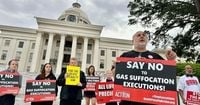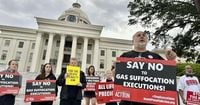Alabama is once again at the center of a heated national debate over the death penalty, as it prepares to execute Anthony Todd Boyd using nitrogen gas in October 2025. Governor Kay Ivey set Boyd’s execution date on August 19, making him the third Alabama death row inmate scheduled for execution in as many months. The planned execution, set to occur between midnight on October 23 and October 24, marks the sixth such event in Alabama this year, reflecting a rapid acceleration in the state’s use of capital punishment—and in particular, its controversial adoption of nitrogen hypoxia as an execution method.
Boyd, who has been on death row since 1995 for the brutal murder of Gregory Huguley in Talladega County, is not going quietly. Currently the chairman of Project Hope to Abolish the Death Penalty, Boyd is actively challenging the state’s chosen execution method in federal court. His lawsuit, filed in July, alleges that Alabama’s nitrogen hypoxia protocol is unconstitutionally cruel, echoing concerns raised by several inmates facing similar fates in the state. According to filings reported by AL Reporter and corroborated by other outlets, Boyd is seeking alternative methods of execution—namely, firing squad, hanging, or medical aid-in-dying—arguing these options would be less likely to inflict unnecessary pain or suffering.
The details of Boyd’s crime are harrowing. Prosecutors say that in 1993, Huguley owed Boyd and three other men $200 for cocaine. When Huguley couldn’t pay, he was kidnapped, bound, doused in gasoline, and burned alive at a rural baseball field. At Boyd’s trial, a witness testified that Boyd taped Huguley’s feet while another man set him on fire. Boyd’s defense, however, presented an alibi, with witnesses claiming he was attending a birthday party and spending the night with his girlfriend at a hotel during the murder. Despite this, a jury convicted Boyd of capital murder and kidnapping in the first degree, recommending the death penalty by a 10–2 vote.
The legal wrangling over Boyd’s execution comes amid a broader controversy regarding Alabama’s use of nitrogen hypoxia. This method, first introduced in Alabama in 2018 as an alternative to lethal injection, was developed in response to the state’s struggles to obtain lethal injection drugs and mounting public scrutiny over execution practices. At the time, death row inmates were given the option to choose nitrogen hypoxia, even though the procedures for carrying it out were not fully developed. Boyd was among those who opted in, a decision he now challenges in court.
Alabama carried out its first nitrogen gas execution in 2024, and since then, five inmates have been executed by this method, with another scheduled for September 2025 before Boyd’s turn arrives. The procedure involves forcing the condemned to breathe pure nitrogen through a gas mask, leading to asphyxiation. State prosecutors, including Attorney General Steve Marshall’s office, maintain that nitrogen hypoxia is painless and causes unconsciousness within seconds. As Marshall’s office wrote, the method “causes unconsciousness within seconds,” and is thus not cruel under constitutional standards.
Yet, Boyd’s lawsuit paints a starkly different picture. Drawing on witness accounts from previous executions, his legal team argues that inmates subjected to nitrogen hypoxia “were observed to gasp for air and struggle against their harness for several minutes after the nitrogen would begin to flow” and “showed signs of conscious suffocation, terror, and pain.” The suit further contends that Alabama’s heavily redacted execution protocol is dangerously vague, failing to specify who oversees key steps or how officials are trained, and omitting instructions for what to do if a prisoner remains conscious after the gas is administered. Boyd’s attorneys argue that, due to his asthma and vertigo, the risk of a painful and prolonged death is even greater in his case.
Alabama officials, for their part, have dismissed Boyd’s legal maneuvering as a stalling tactic. In court filings, the state claims Boyd is “less concerned with the legitimacy of his claims than with throwing a spanner into the State’s execution process.” Officials also argue that the disturbing movements reported during previous nitrogen executions—such as convulsing and gasping—are either signs of resistance or “involuntary movements associated with dying,” not evidence of unconstitutional suffering.
Adding to the complexity, secrecy laws in Alabama keep many details about the nitrogen hypoxia procedure hidden from both the public and the inmates themselves. While the state released a redacted protocol in 2023, much of the operational detail remains classified. What is known, according to reporting from AL Reporter and other outlets, is that condemned individuals are forced to breathe pure nitrogen through a gas mask until they succumb to asphyxiation. Boyd’s lawsuit accuses the state of lacking “sufficient safeguards to prevent conscious suffocation from happening.”
The upcoming federal court hearing on September 4 will consider Boyd’s request to block his execution by nitrogen and weigh his proposed alternatives. Legal experts note that, so far, no court has ruled against Alabama’s use of nitrogen hypoxia, despite mounting anecdotal evidence and legal challenges from inmates and advocates. Outside of Alabama, only Louisiana has ever used nitrogen hypoxia to execute a death row inmate, though Arkansas, Mississippi, and Oklahoma also allow the procedure.
Boyd’s case is not happening in a vacuum. Alabama’s recent acceleration of executions, and its willingness to test new methods, has drawn national attention and reignited debates over capital punishment in the United States. The state’s use of nitrogen hypoxia—still experimental by most standards—has become a flashpoint for critics who argue it constitutes cruel and unusual punishment, as well as for officials who insist it is a humane solution to the logistical and ethical challenges posed by lethal injection.
Meanwhile, the state’s execution schedule continues unabated. David Lee Roberts’ execution by nitrogen hypoxia, originally set for August 21, has been put on hold pending a mental competency assessment by the Alabama Department of Mental Health. Geoffrey Todd West is scheduled for execution by nitrogen gas between midnight on September 25 and 6 a.m. on September 26. All eyes now turn to the federal court, where Boyd’s fate—and perhaps the future of nitrogen hypoxia as a legal execution method—hangs in the balance.
As Alabama moves forward with its plans, the outcome of Boyd’s legal battle could set a precedent for how, and whether, states can continue to innovate—or experiment—in the administration of capital punishment.





